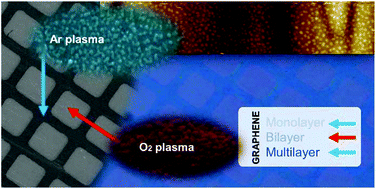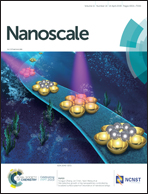Selective growth of monolayer and bilayer graphene patterns by a rapid growth method†
Abstract
The use of next-generation graphene requires the control of the number of deposition layers together with its fast synthesis for its use in advanced and miniaturized devices. Here, this article describes a novel technique for the selective growth of a continuous film of a graphene pattern (controlled monolayer/multilayer design) by the chemical vapor deposition (CVD) method on Cu foils modified by different plasma treatments. Ex situ Ar plasma treatment is the preferred treatment for monolayer graphene (I2D/IG = 1.81) synthesis. Bilayer graphene (I2D/IG = 1.05) growth was influenced by applying an additional oxygen plasma treatment, which led to different morphologies and control of the surface-active nature of Cu. The required design was achieved by a photolithography process. Graphene synthesis was performed by a short annealing process (60 s) followed by a single-step short burst of graphene growth (60 s). Relatively high density graphene nuclei with faster graphene growth resulted in monolayer graphene in the Ar plasma-treated area. Ex situ oxygen plasma treatment in selected areas was capable of controlling the amount of graphene nuclei formation, while the kink structure was capable of bolstering the adsorption of a relatively high amount of carbon adatoms, resulting in bilayer graphene.



 Please wait while we load your content...
Please wait while we load your content...